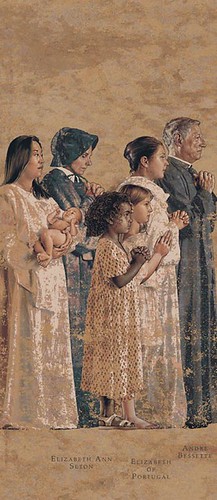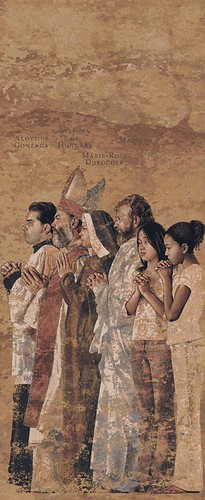 Over the years, I’ve collected several images of saints. It started with a ceramic relief of Saint Cecilia that the members of the Newman Center choir at UCLA gave me as a birthday present. Then a fellow campus minister at Saint Mary’s College in Moraga found a retablo of Saint Librata (also known as Wilgefortis or “holy face”). The legend of this deposed saint (she was removed from the calendar in 1969) tells of her martyrdom on a cross in which she appeared to have the face of Christ. Thus, many of her images show a crucified person with a beard wearing women’s clothing. She is said to be the patron saint of difficult marriages and unwarranted advances by men.
Over the years, I’ve collected several images of saints. It started with a ceramic relief of Saint Cecilia that the members of the Newman Center choir at UCLA gave me as a birthday present. Then a fellow campus minister at Saint Mary’s College in Moraga found a retablo of Saint Librata (also known as Wilgefortis or “holy face”). The legend of this deposed saint (she was removed from the calendar in 1969) tells of her martyrdom on a cross in which she appeared to have the face of Christ. Thus, many of her images show a crucified person with a beard wearing women’s clothing. She is said to be the patron saint of difficult marriages and unwarranted advances by men. But one of my favorite retablos is one I found years ago at the Religious Education Congress, of all places! It’s a small image of a man with a halo walking—more like marching—with a look of determination. Behold, Saint Expeditus, patron of urgent situations, emergencies, and procrastinators!
But one of my favorite retablos is one I found years ago at the Religious Education Congress, of all places! It’s a small image of a man with a halo walking—more like marching—with a look of determination. Behold, Saint Expeditus, patron of urgent situations, emergencies, and procrastinators!All this time, I thought he was a made-up saint. But he’s not! He has a novena, and his feast day is April 19 (four days after Tax Day), but as his fans say, you can celebrate Saint Expy day whenever you get around to it.
The saints indeed know all about our lives and can be models for us on how to deal with the troubles we face each day. Yet the saints really aren’t distant onlookers. They’re here among us. We don’t so much pray to them as we pray with them.
 One of the most striking things about the Cathedral of Our Lady of the Angels in Los Angeles is the way the saints face. They aren’t looking at you; they’re standing with you, joining you in prayer around the altar. It’s a beautiful image of what it means to be part of the communion of saints.
One of the most striking things about the Cathedral of Our Lady of the Angels in Los Angeles is the way the saints face. They aren’t looking at you; they’re standing with you, joining you in prayer around the altar. It’s a beautiful image of what it means to be part of the communion of saints.The Catechism of the Catholic Church (948) speaks of two aspects of the communion of saints which it sums up in the Eastern liturgy’s invitation to Communion: “Holy gifts for holy people!” The communion of saints is first a sharing of the good things God gives us, the most wonderful of which is Eucharist. Thus the tapestries at Los Angeles’ Cathedral show the saints standing with us at the altar. Being part of the communion of saints also means that we are united—in communion—with all the living and the dead, all God’s holy people.
That sharing and that communion come together at the altar—the tomb—of the model after which all the saints are formed: Christ. The cult of saints began in the early church when Christians were being persecuted and killed for their faith. Christians would recall their example of faith, often celebrating Eucharist on the anniversary of their death. Their burial places were holy sites where “heaven is joined to earth”—where death in Christ was wedded to eternal life in heaven. These sites were thought to be where one could receive some of the grace of the saint (sharing in the good things of God). Therefore, stone slabs were sometimes placed on top of the martyrs’ graves so the pilgrims could celebrate Mass there. These graves eventually became pilgrimage destinations around which monasteries, chapels, and religious houses were built. (Ever wondered why relics are embedded in the altar?)
Saints model for us how to live because saints show us how to die—die to selfishness and self-preservation; to worrying that you won’t have enough and to worrying that you aren’t good enough; to harboring grudges and withholding forgiveness; to apathy and to waiting until tomorrow to do what needs to be done today—saying “I love you,” “I’m sorry,” “I forgive you.”
They are called saints because in some way they stood apart from the rest of world and showed us how to be counter to what was expected, especially in times of trial.
The poor family who doesn’t have enough food to feed themselves yet welcomes in the stranger with open arms and the best of their kitchen stands apart from those who have more than enough yet have no joy around their table. Blessed are the poor in spirit, for theirs is the Kingdom of heaven.
Those Amish who forgave their children’s murderer, attended his funeral, and vowed to support his widow and their children stood apart from what most of the rest of us would have done. Blessed are the merciful, for they will be shown mercy.
Those prophets of faithful dissent who speak out against injustice—even injustice in the Church—and are condemned for it stand apart from our “don’t rock the boat” and “keep your head down” indifference. Blessed are you when they insult you and persecute you and utter every kind of evil against you falsely because of me. Rejoice and be glad, for your reward will be great in heaven.
The saints stand apart, yet they do not stand alone. All the holy ones of God—you and me and the saints—stand together, dying to ourselves and rising to holiness, sharing in the good things of God.

But now in Christ Jesus you who once were far off have become near by the blood of Christ. For he is our peace, he who made both one and broke down the dividing wall of enmity, through his flesh, abolishing the law with its commandments and legal claims, that he might create in himself one new person in place of the two, thus establishing peace, and might reconcile both with God, in one body, through the cross, putting that enmity to death by it. He came and preached peace to you who were far off and peace to those who were near, for through him we both have access in one Spirit to the Father. So then you are no longer strangers and sojourners, but you are fellow citizens with the holy ones and members of the household of God, built upon the foundation of the apostles and prophets, with Christ Jesus himself as the capstone. Through him the whole structure is held together and grows into a temple sacred in the Lord; in him you also are being built together into a dwelling place of God in the Spirit. (Ephesians 2:13-22)
No comments:
Post a Comment